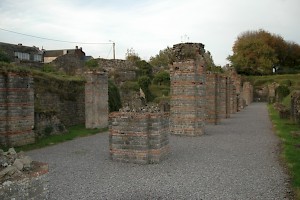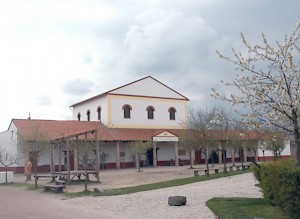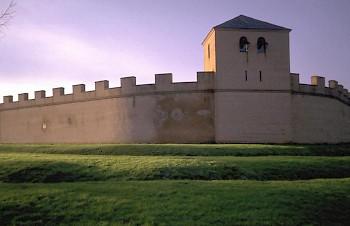Germania Inferior (6)
Q152136Germania inferior: small province of the Roman empire, situated along the Lower Rhine. Its capital was Cologne.
The towns (continued)

In front of the most important temple of the town was, still on the central square, the town hall. It is a pity that these buildings have not been discovered in Germania Inferior, because it was not unusual to decorate them with inscriptions that contained the texts of important decrees. If we would possess these bronze tablets, we would know a lot more about political life in the ancient Low Countries. What we do know, however, is that the communities were administered by two supreme magistrates, elected for one year, and a council in which some eighty wealthy men deliberated. In Italy, only people with "old money" were invited to run for the magistracies; north of the Alps, nouveaux riches were welcome too.

Town halls were not the only centers of the Roman civil government in Germania Inferior. In Cologne, the praetorium has been excavated, the governor's residence. It was built c.50 as the headquarters of the army of the Lower Rhine, but became the palace of the governor when the military zone became a province in the normal sense of the word. The building occupied a surface area of about 3½ hectares and must have been one of the largest in Germania Inferior. Its eastern wall was close to the Rhine and must have been very impressive - showing the power of Rome to the Germanic tribes on the other bank. Beautiful mosaics decorated the floors, and we know that this was the place where the governor received important visitors. In these rooms, which are currently accessible, at least two governors were recognized as emperor: Vitellius and Trajan.

The list of important buildings in a city quoted above also mentioned a training-ground. More than pubs and cafés in our own age, the gymnasium was the place to meet friends. Often, the training-grounds were part of the bathhouse or thermae. The most beautiful (but not the only) example in Germania Inferior has been excavated in Heerlen (and reconstructed in the Archeon). Visitors were able to train their bodies on a field near the building or in the swimming pool, or could use the cold, tepid, and warm baths, or enjoy the sauna, the restaurant or the library. The combination of bathhouse, library and restaurant may surprise us, but the Romans were accustomed to it. If they wanted to say that someone was illiterate, they said he could not swim.

A bathhouse must be connected to an aqueduct and a sewer system. These works are among the greatest triumphs of ancient engineering, but it is difficult to evaluate their effects. The presence of clean water and the washing down of dirt were no doubt very positive, but on the other hand, the thermae were visited by both healthy and unhealthy people at the same time. They must have been sources of illness. In Rome, we know of various kinds of infections, and the situation in Germania Inferior cannot have been very different.
Sewers and aqueducts have been discovered in almost every ancient Roman city and can be visited at Cologne.
Medicinal sources are known from the country of the Tungri. The Roman author Pliny the Elder mentions a well that produces strange tasting water, which cures several illnesses. A well is shown to visitors of modern Tongeren ("Pliniusbron"), but it does not really fit the description. Probably, Pliny refers to the medicinal sources of Spa or Aix-la-Chapelle.

The last point on the list was the theater. Cologne had a real playhouse, but elsewhere, actors must have used the amphitheaters, even though these buildings were originally meant for hunting parties and gladiatorial contests. They are well-known from Germania Inferior (e.g., Xanten and Nijmegen). It did not really matter whether the performance took place in a real theater or an amphitheater, because there was not much difference between a Roman play and an execution. In comedies and tragedies, the hero died miserably, and this was shown to the audience (with a convicted criminal serving as stand-in).

The gridiron-city was often surrounded by walls. The town wall of Cologne was 2½ meters wide and eight meters high. Even in peace time, these fortifications must have impressed any visitor, especially the Germanic tribes on the other bank of the Rhine. No less impressive were the walls that surrounded Tongeren: six meters high, two meters wide and no less than four kilometers long. Built by the emperors Trajan and Hadrian, they are still visible. A mystery is why these walls were erected at this time, because the second century was an age of peace. That they had no real military function is suggested by the fact that there was a granary outside the walls.

Outside the city gates were the cemeteries, because Roman law prohibited tombs within the walls. There were several funerary traditions in the Low Countries, and the key-word to describe them is 'pluralism'. Military cemeteries were different from civil graveyards, and Cananefates were interred in another fashion than Menapians. Cremation was the most common practice, but sometimes people were buried. Often, the deceased received several gifts, like weapons, brooches, pins, pottery, or a piece of sucking pig. A ten-year old girl from the neighborhood of Nijmegen was buried with her tambourines. In several regions, however, the gifts were absent - funerary traditions differed, just like there was considerable variance in the urns and coffins.
Sepulchral monuments could be very different from each other too. Many important people ordered the construction of a burial mound. They can be seen on several places along the ancient road from Tongeren to Bavay. Other burials were marked by a wooden tombstone, a smill brick pyramid or a roof. And of course there were show-offs who conspicuously displayed their wealth. At Cologne, one Lucius Poblicius, former officer of the Fifth Legion Alaudae, erected a tower of fifteen meters high and dedicated it to himself.